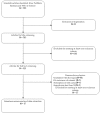Can routine oral care with antiseptics prevent ventilator-associated pneumonia in patients receiving mechanical ventilation? An update meta-analysis from 17 randomized controlled trials
- PMID: 25932093
- PMCID: PMC4402740
Can routine oral care with antiseptics prevent ventilator-associated pneumonia in patients receiving mechanical ventilation? An update meta-analysis from 17 randomized controlled trials
Abstract
Background: Whether oral antiseptics could reduce the risk of ventilator associated pneumonia (VAP) in patients receiving mechanical ventilation remains controversial. We performed a meta-analysis to assess the effect of oral care with antiseptics on the prevalence of ventilator associated pneumonia in adult critically ill patients.
Methods: A comprehensive search of PubMed, Embase and Web of Science were performed to identity relevant studies. Eligible studies were randomized controlled trials of mechanically ventilated adult patients receiving oral care with antiseptics. The quality of included studies was assessed by the Jadad score. Relative risks (RRs), weighted mean differences (WMDs), and 95% confidence intervals (CIs) were calculated and pooled using a fixed-effects model or random-effects model. Heterogeneity among the studies was assessed with I (2) test.
Results: 17 studies with a total number of 4249 met the inclusion criteria. Of the 17 studies, 14 assessed the effect of chlorhexidine, and 3 investigated the effect of povidone-iodine. Overall, oral care with antiseptics significantly reduced the prevalence of VAP (RR=0.72, 95% CI: 0.57, 0.92; P=0.008). The use of chlorhexidine was shown to be effective (RR=0.73, 95% CI: 0.57, 0.93; P=0.012), whereas this effect was not observed in povidone-iodine (RR=0.51, 95% CI: 0.09, 2.82; P=0.438). Subgroup analyses showed that oral antiseptics were most marked in cardiac surgery patients (RR=0.54, 95% CI: 0.39, 0.74; P=0.00). Patients with oral antiseptics did not have a reduction in intensive care unit (ICU) mortality (RR=1.11, 95% CI: 0.95, 1.29; P=0.201), length of ICU stay (WMD=-0.10 days, 95% CI: -0.25, 0.05; P=0.188), or duration of mechanical ventilation (WMD=-0.05 days, 95% CI: -0.14, 0.04; P=0.260).
Conclusion: Oral care with antiseptics significantly reduced the prevalence of VAP. Chlorhexidine application prevented the occurrence of VAP in mechanically ventilated patients but povidone-iodine did not. Further large-scale, well-designed randomized controlled trials are needed to identify the findings and determine the effect of povidone-iodine application.
Keywords: Oral care; antiseptics; meta-analysis; ventilator associated pneumonia.
Figures








References
-
- American Thoracic Society. Infectious Diseases Society of America: Guidelines for the management of adults with hospital-acquired, ventilator-associated, and healthcare-associated pneumonia. Am J Respir Crit Care Med. 2005;171:388–416. - PubMed
-
- Chastre J, Fagon JY. Ventilator-associated pneumonia. Am J Respir Crit Care Med. 2002;165:867–903. - PubMed
-
- Safdar N, Dezfulian C, Collard HR, Saint S. Clinical and economic consequences of ventilator-associated pneumonia: a systematic review. Crit Care Med. 2005;33:2184–93. - PubMed
-
- Rello J, Ollendorf DA, Oster G. Epidemiology and outcomes of ventilator-associated pneumonia in a large US database. Chest. 2002;122:2115–2121. - PubMed
-
- Bercault N, Boulain T. Mortality rate attributable to ventilator-associated nosocomial pneumonia in an adult intensive care unit: A prospective case-control study. Crit Care Med. 2001;29:2303–2309. - PubMed
LinkOut - more resources
Full Text Sources
Miscellaneous
